Wuhan - capital city of Hubei Province, China
Wuhan (dead link: January 2023) (武汉; Wǔhàn) is the capital of Hubei Province in China and a major port on the Yangtze River.
Districts
 Wuhan has 13 administrative districts, which Wikivoyage has grouped as follows:
Wuchang (Wuchang District)
Wuhan has 13 administrative districts, which Wikivoyage has grouped as follows:
Wuchang (Wuchang District)
Eastern Wuhan (Hongshan District, Qingshan District and the areas of Wuchang District bordering the East Lake)
Hankou (Jiang'an District, Jianghan District, Qiaokou District and Dongxihu District)
Hanyang (Hanyang District, Caidian District and Hannan District)
Northern Wuhan (Huangpi District and Xinzhou District)
Jiangxia (Jiangxia District)
Wuhan was created in the early 20th century by amalgamating the three cities of Wuchang, Hankou and Hanyang.
Understand
History
Wuhan once consisted of three cities; Hanyang, Hankou (formerly known as Hankow), and Wuchang. Hanyang was a busy port as long as 2,000 years ago in the Han Dynasty. Yellow Crane Tower was built in 223 BCE and gained fame throughout China through the poetry of Cui Hao during the Tang Dynasty. Wuchang has been a center of learning for centuries, especially in the field of the arts. It became a provincial capital in the Yuan Dynasty.
Hankou was considered to be one of China's top four cities during the Ming and Qing Dynasties. It was the busiest inland port, first opened as a treaty port in 1861. During the 19th century, as a result of concessions granted in the aftermath of the Opium Wars, large areas of Hankou's riverfront were carved up into foreign mercantile divisions with port and rail facilities and the area's economy expanded rapidly. There remain many grand buildings along Hankou's riverfront clearly European in design as a result.
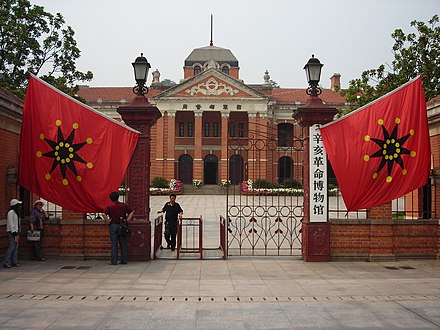
In 1927, Hanyang, Hankou, and Wuchang were united to form the city of Wuhan. In 1938, during the Japanese invasion of China, Wuhan briefly became the temporary capital of the Republic of China, after the government had been moved here from Nanjing, which had been captured by the invaders. In the late 1938, however, Wuhan fell to the Japanese as well, and the ROC government moved further west to Chongqing. During the rest of World War II, fighting shifted to the western part of Hubei, Wuhan being liberated from the invaders only with the surrender of Japan in 1945.
With the opening of China, Wuhan was reopened in 1992 for the first time since the revolution. Today, Wuhan is one of China's largest cities and remains an important center of commerce. While many visitors overlook Wuhan as just another city, beneath its industrial exterior a rewarding tapestry of history and cultural arts awaits. It is also one of China's most important railway hubs, fulfilling the same role for China that Chicago does for the United States.
The COVID-19 virus was first identified in Wuhan in December 2019, and the exponential growth in number of infections prompted authorities to implement a lockdown that continued for 2.5 months. After some widespread testing and centralized treatment, which included building a new hospital for COVID-19 patients in 10 days, the local outbreak officially came to an end in early April 2020.
Orientation
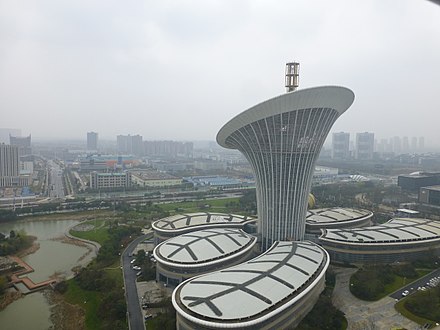
Yangtze bridges
Vehicles can cross the Yangtze over nine bridges and a tunnel within the city limits, but only two of these may be used by pedestrians and cyclists.
Number One Yangtze River Bridge 📍 spans the Yangtze 1 km upstream of its confluence with the Han. It's a colossus, with a railway on its lower deck, and a highway plus sidewalks on the upper deck. On the west bank, Hanyang, the sidewalks start at the corner of Guishan S. Rd and Yingwu Ave; there is also access to the northern sidewalk from the park outside the TV tower. On the east bank, Wuchang, several stairways access the bridge west of the Yellow Crane Tower.
The more graceful Number Two Yangtze River Bridge, 5 km downstream, connects Wuchang with Hankou, and is also open to pedestrians as well as vehicles.
Most of the bridges over the smaller Han River, connecting Hanyang and Hankou, have pedestrian sidewalks.
Climate
Travellers not accustomed to high heat and humidity should avoid visiting Wuhan in the summer months. As the hottest of the "Three Furnaces" of China (the others are Chongqing and Nanjing), Wuhan often gets summer temperatures above 35 °C (95 °F). Combine the heat with humidity, a lack of wind, and heavy urban pollution typical for most of the rapidly industrialized cities in China, and you have a recipe for a cloudy yet simmering day.
Get in
Wuhan is a major city in a central position. It has all the bus, rail, road and air connections you would expect.
By plane
- Wuhan Tianhe International Airport (IATA: WUH), 30.772483°, 114.205304°. Flights from all major domestic airports are available, including Xian, Beijing, Shanghai, Chengdu, Hong Kong. International flights operate from Taipei, Seoul, Tokyo, Singapore, Paris, and Moscow.
Taxi from Wuhan Tianhe Airport to the city (Wuchang) costs ¥70-¥80, plus ¥10 toll.
A commuter rail line connecting Wuhan's Hankou Railway Station with the city of Xiaogan, has a stop at the airport. The train schedule is somewhat irregular, but, as of 2017, there is typically a train from the airport station (天河机场) to Hankou (汉口) Railway Station every 1-1½ hours. At Hankou, you can transfer to Wuhan Metro (subway), or to long-distance or commuter trains to various destinations. Some of the trains from the airport may continue beyond Hankou, to other cities in Hubei, such as Huanggang/Daye/Huangshi (with a stop at Wuhan Railway Station), or Yichang, Xiangyang and Shiyan. (Schedule).
Wuhan Metro's Line 2 also reaches the airport, providing frequent and inexpensive service to destinations throughout the city. As of 2018, Metro Line 2 trains run to and from the airport from 06:00 to 22:30.
As of 2015, there was regular bus service from Wuhan airport to several locations throughout Wuhan, including the Hankou and Wuhan railway stations and the Fujiapo Bus Station (in downtown Wuchang, within 1 km from the Wuchang Railway Station). These services may have been affected by the opening of the rail and metro connection to the airport, though.
If you get stuck at the airport for any length of time, the airport has free wifi throughout the domestic terminal (subject to verification of mobile phone number, any country OK), and you can find power outlets (with purchase) at Cite Coffee on the mezzanine above the pre-security departures hall (2F). There is a left-luggage service on the back wall of the departures hall as well, next to the odd-sized luggage check.
By train
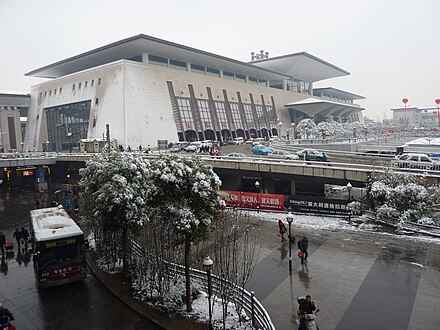
There are three main railway stations: Wuhan Railway Station 📍 has the fastest trains. The others are Wuchang Railway Station 📍, and Hankou Railway Station 📍. All three stations are connected by the metro.
Going north
- Beijing: 4 hr (G-series), 7½ hr (D-series), frequent service from Wuhan station; 10½ hr (Z- or T-series, including overnight trains), from Wuchang or Hankou
- Shijiazhuang: 4-5 hr (G, D), frequent service from Wuhan station
- Taiyuan: 5½-6 hr (G), two trains a day from Wuhan; you can also travel with a transfer in Shijiazhuang
- Zhengzhou: 2 hr (G), 3½ hr (D), frequent service from Wuhan station
- Tianjin: 13 hr (T, from Wuchang); faster travel by G or D train is possible with a transfer in Beijing (terminal change) or Nanjing
- Harbin: 13 hr (G, from Wuhan); 23-28 hr (T, from Wuchang or Hankou)
- Changchun: 25 hr (T, from Wuchang or Hankou)
- Shenyang: 19 hr (T236/T237 from Wuchang)
- Hohhot: 26-28 hr (K1276/K1277 or K600/K597 from Wuchang); much faster travel is possible by taking a G or D train to Beijing and transferring to T train there
Destinations in Northeastern China (e.g. Harbin) will involve changing between stations in Beijing.
Going north-west
- Xi'an: 4 hr (G, from Wuhan); 12-15 hr (overnight T or K train, from Wuchang)
- Lanzhou: 3 hr (G96/G97 from Wuhan); 17 hr (T264/T265, from Wuchang)
- Ürümqi: 15 hr, change in Lanzhou
- Xining: 21 hr (T264/T265, from Wuchang). Same day travel is possible by high-speed trains with a transfer in Xi'an
- Lhasa: 44 hr (T264/T265, from Wuchang); runs every other day.
- Yinchuan: 30½ hr (K1296/K1297, from Wuchang); much faster travel is possible by taking a G train to Shijiazhuang or Taiyuan and transferring there

Going south
- Guangzhou, Shenzhen: 4-7 hr (G, D), frequent service from Wuhan; 11-13 hours (Z, T, including overnight trains), from Wuchang or Hankou
- Changsha: 1½-2 hr (G, D), frequent service from Wuhan station
- Guilin: 5½ hr (G), from Wuhan (one train daily); 12 hr (T, K, overnight train from Wuchang)
- Nanning: 8 hr (G, from Wuhan); 18½-19½ hr (T, from Wuchang)
- Haikou: 21½ hr (T201, from Wuchang)

Going east
- Shanghai: 5½-6 hr (G, D), frequent service mostly from Hankou, some from Wuchang or Wuhan; 10 hr, overnight Z train from Wuchang
- Nanjing: 3½-4 hr (G, D), frequent service mostly from Hankou, some from Wuchang or Wuhan
- Hefei, 2½ hrs (G, D), frequent service mostly from Hankou, some from Wuchang or Wuhan
- Hangzhou: 5½-6 hours (G, D), mostly from Hankou; you can also travel with a transfer in Nanjing; 8½ hr, overnight Z train from Wuchang
- Qingdao: 8 hr (G), from Wuhan, one direct train daily; you can also travel on G or D trains with a transfer in Nanjing
Going south-east
- Nanchang: 2½-3 hr (D), from all terminals
- Fuzhou: 7-7½ hr (D, G), from Wuhan or Hankou
Going west
- Chongqing: 7 hr (D or G, mostly from Hankou); 13-15 hr (T or K, overnight trains from all terminals)
- Chengdu: 8½-9 hours (D, mostly from Hankou, some from Wuhan); 11 hr (Z) or 16-17 hr (T), mostly overnight, from all terminals
Going south-west
- Kunming: 7-8 hr (G, from Wuhan); 24 hr (Z, from Wuchang)
- Guiyang: 5 hr (G, from Wuhan); 17½ hr (T, from Wuchang)
Commuter services
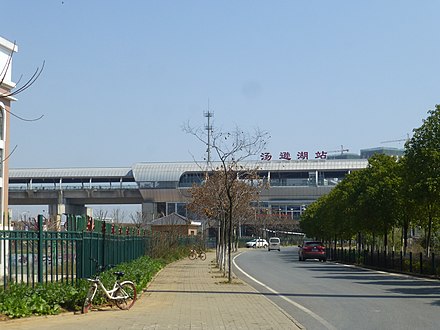
As of 2018, on most lines, trains run about 10 times a day in each direction. The trains depart from the same three main train stations of the city, but use dedicated purpose-built rail lines, different from both the "regular" and high-speed railway lines used by long-distance trains. They also make a few stops at new purpose-built commuter stations on the city's outskirts; e.g. the Xianning-bound trains stop at the Tangxunhu Station (汤逊湖站) in the southern part of the Guanggu development area, from which a bus or a streetcar can be taken to various university or corporate campuses.
The system is undergoing further development; once the new Guanggu Railway Station (光谷火车站; formerly known as the Liufang Station) opens in the middle of the Guanggu development area later in 2020, the commuter service will be much improved.
By bus
Major bus stations
There are several major long-distance bus stations, again in Hankou and Wuchang, which tend to have buses visiting more than one station. The bus station with the most number of services is the Xinrong Bus Station in Hankou. The second and third busiest bus stations are Hongji Bus Station and Gutian Bus Station respectively.
- Fujiapo Bus Station (傅家坡汽车客运站), 358 Wuluo Road, Wuchang District (武昌区武珞路358号) (About 700 metres north of Meiyuan Xiaoqu Metro Station on Line 4), 30.5374125500°, 114.3213416500°, +86 27 87274817. 2020-02-27
- Gutian Bus Station (古田客运站), 8 Gutian First Road, Qiaokou District, Hankou (汉口硚口区古田一路8号) (Close to Gutian First Road Metro Station on Line 1), 30.6074258000°, 114.1796621100°, +86 27 63604599. 2020-02-27
- Hanghai Bus Station (航海汽车客运站), 528 Zhongshan Road, Wuchang District (武昌区中山路528号) (Opposite the west side of Wuchang Railway Station, about 700 metres south of Wuchang Railway Station Metro Station on Lines 4 and 7), 30.5298228400°, 114.3080479700°, +86 27 88318111. 2020-02-27
- Hongji Bus Station (宏基汽车客运站), 519 Zhongshan Road, Wuchang District (武昌区中山路519号) (Just outside Exit F of the Wuchang Railway Station Metro Station on Lines 4 and 7), 30.5359280500°, 114.3120934000°, +86 27 88074966, +86 27 88074968. 2020-02-27
- Xinrong Bus Station (新荣村客运站, 新荣村客运站 Xinrong Village Bus Station), 1 Hanhuang Road, Jiang'an District, Hankou (汉口江岸区汉黄路1号) (Just outside Exits C and D of the Xinrong Bus Station Metro Station on Line 21. You could also walk here from Xinrong Metro Station on Line 1), 30.6610944300°, 114.3270377700°, +86 27 82321055. 2020-02-27
The Jinjiadun Bus Station (金家墩客运站) near Hankou Railway Station was permanently closed in 2017. A brand new bus station is being built at the site and should be completed by the mid-2020s.
Other bus stations
- Hanyang Passenger Transport Centre (汉阳客运中心,汉阳客运站, Hanyang Bus Station), 211 Longyang Avenue, Caidian District (蔡甸区龙阳大道211号) (Just outside Exit A of Hanyang Bus Station Metro Station on Line 3), 30.5288034900°, 114.1838429300°, +86 27 68841281. Mainly serves bus routes from other cities in Hubei Province and some neighbouring provinces. 2020-02-27
By boat
You can also reach Wuhan via boats on the Yangtze River, either from downstream centers such as Shanghai and Nanjing or from Chongqing further upstream, via the famous Three Gorges route.
These days, only cruise boats are available. Regular commuter-style services ceased operations many years ago. Moreover, most cruise boats on the Yangtze only travel between Chongqing and Yichang and do not reach Wuhan or cities further east. Yichang may be reached in about 2-hours by high-speed train.
- Wuhan Passenger Port (武汉客运港), 145 Yanjiang Avenue, Jiang'an District, Hankou (汉口江岸区沿江大道145号) (About 1 km east of Jianghan Road Metro Station on Lines 2 and 6. The port terminal is inside the same building as the Wuhan Museum of Science and Technology. You will find it on the northern side of the building), 30.5826704100°, 114.2950581900°, +86 27 82965006 (Jianghan Chaozong Tourist Transportation Center), +86 27 82839544 (port authority), whg@wuhanport.com. Wuhan's main cruise boat terminal. The port is also a departure point for short-distance evening pleasure cruises (which are much more frequent than cruises to Shanghai or Chongqing). The boats usually dock at Pier No. 23. The ticket office is inside the Jianghan Chaozong Tourist Transportation Center (武汉江汉朝宗旅游集散中心). There are also several travel agencies inside the center that can help you with bookings. 2020-02-27
Get around
By metro
Wuhan Metro. Starting with a modest beginning in 2004, Wuhan's metro system has grown by the end of 2017 to an elaborate network with 7 lines and 167 stations, connecting all three major sections of the city (Hankou, Hanyang, and Wuchang); it continues to expand at a rapid pace.
The airport and the Hankou Railway Station are served by Line 2; the Wuhan Railway station (the major high speed railway station) and the Wuchang Railway Station, by Line 4.
As in most other subway systems in China, the fare depends on distance. For a single trip, you can buy a token from a vending machine at the station's entrance, use the token to enter the system at a turnstile, and then surrender it to another turnstile when exiting. You can also buy a Wuhan Tong card (from the person at the booth in the subway, or elsewhere) for ¥15 and add cash value to it, allowing you to enter the stations more quickly; subway rides using the Wuhan Tong are discounted by 10%, and the Wuhan Tong also works on public buses and ferries.
Stations are clean, and the trains are usually (outside of the rush hour) not very crowded. Public toilets are available at many stations (usually, outside the toll gate); drinking water fountains are found on the platforms of some stations.
It is useful to be aware of where subway construction work is being carried out, since large sections of streets may be fenced off for the construction, and street-level traffic may be significantly affected during the construction work.

By bus
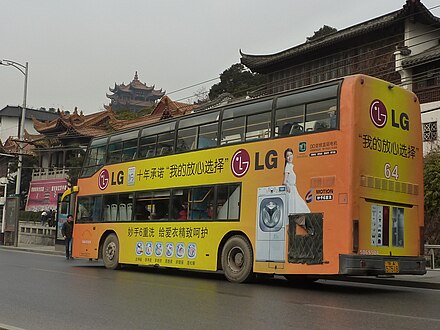
Maps sold at newsstands etc for a few yuan show bus routes and bus stops, but aren't always easy to read, and aren't always up-to-date. There is an interactive Wuhan bus map (dead link: December 2020) (in Chinese) available online, which allows you to see bus connections between any two bus stops. The Baidu Maps web site also has information about the bus service.
There are also several Bus Rapid Transit (BRT) lines. These have stations somewhat similar to those of the metro; you pay at the entrance into the station, rather than when boarding the bus. BRT Line 1 runs east from Wuchang Railway Station, along the Xiongchu St (mostly parallel to Line 2 of the Metro, but about 1-2 km south of it).
By streetcar
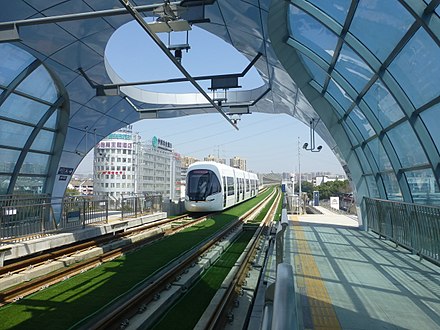
One system operates in the far reaches of Hanyang, connecting to the subway Line 3 at Zhuanyang Boulevard Station (沌阳大道站).
The other system, opened in 2018, operates in the Guanggu ("Optics Valley") area of Wuchang. Its lines start near the main gate of the Huazhong Science and Technology University (stations Luoxiong Rd and Huazhong Science and Technology University of subway Line 2), and run south and south-east, passing by various university and corporate campuses of the area; one of them (L2) reaches the Tangsunhu Station of the Wuchang-Xianning commuter train line.
By taxi
Taxis are sometimes hard to find, especially in commercial areas. Taxis are supposed to switch drivers at 17:30 however often they will appear to do so much earlier. After 16:00, expect half of all taxis to display a sign indicating they are not for hire. In congested areas, especially 1-way streets with no convenient exit, taxi drivers displaying the for hire sign (空车) will often wave you away when you try to flag them down or stop the car to ask where you are going and dismiss you if it's not to an area they wish to go to. Be aware and plan accordingly if you have to be somewhere on-time. The lack of adequate taxis in congested areas (Wuhan Plaza, for example), people in Wuhan are much more aggressive when trying to get a taxi. Expect to race to any car that stops and to hold your ground at the door (for example if you're waiting at the front door, someone will jump in the back). Rates are relatively cheap at ¥6 on the flag and with around ¥70 getting you between almost any two spots you are likely to want to travel between. It is possible to get higher taxi fares, but usually only because the taxi driver has deliberately taken you on a longer trip (which is, thankfully, not a common occurrence).
Airport taxis are the exception. Foreigners in particular are likely to get ripped off by taxi drivers at the airport. They will demand prices starting at ¥150 to go anywhere in the city. For reference, going from the airport to the middle of Hanyang costs about ¥50 typically. It is advisable to insist on the metre before the taxi starts moving and if the driver refuses, step out, collect your luggage and go back to the taxi stand. This is not a serious problem in the daytime when there is a supervisor at the taxi stand who is an airport employee, rather than a taxi driver.
One oddity of the taxi system is crossing the bridges. Because of the traffic problems and snarls at the bridges, the city has instituted a system in which half the taxis are not permitted to cross the bridge on half the days. Basically, if the day of the month is odd, odd-numbered taxis are allowed to use the Number One Bridge. If the day of the month is even, even-numbered taxis are allowed to use the Number One Bridge. This system may extend to the Number Two Bridge (this is not yet confirmed) but it does not extend to the Number Three Bridge. In most circumstances, however, it is not advisable to use the Number Three Bridge as it tends to increase the taxi fares dramatically (although it is an interesting ride).
By ferry
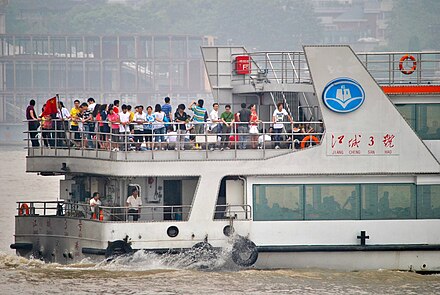 The Yangtze River can be crossed by ferry for a very reasonable fee of ¥1.5. The ferry offers by virtue of its unique location some nice views of the city, the Number One Yangtze River Bridge, Yellow Crane Tower, etc. during the day and an interesting nightscape view after dark.
The Yangtze River can be crossed by ferry for a very reasonable fee of ¥1.5. The ferry offers by virtue of its unique location some nice views of the city, the Number One Yangtze River Bridge, Yellow Crane Tower, etc. during the day and an interesting nightscape view after dark.
The main ferry route is between the Wuhan Customs House Wharf in Hankou and Zhonghua Road Wharf in Wuchang. The ferry on this route runs frequently starting at 06:30 and ending at 24:00. The fare is increased to ¥10 after 20:10. A special express ferry operates on the same route between 08:45 and 17:25. The fare for the express ferry is ¥5.
- Wuhan Customs House Wharf (武汉关码头), 14 Yanjiang Avenue Riverside, Jianghan District, Hankou (汉口江汉区沿江大道江滩14号) (About 900 metres southeast of Jianghan Road Metro Station on Lines 2 and 6. Near the Hankou Customs House Museum.), 30.5746728000°, 114.2909232000°. 2020-02-28
- Zhonghua Road Wharf (中华路码头), 78 Linjiang Avenue Riverside, Wuchang District (武昌区临江大道江滩78号) (About 1.5km northwest of the Yellow Crane Tower. About 2 km west of Xiaodongmen Metro Station on Line 7), 30.5532454600°, 114.2895604300°, +86 27 88871575. 2020-02-28
By car
Wuhan's perpetually snarled traffic has long been famous. The city, however, has invested a lot of money and effort in improving the road infrastructure. In the 2000s, a popular type of project was building two-level intersections at important street crossings, or putting sections of a street underground in locations with a lot of pedestrian traffic (e.g. in front of Wuchang or Hankou Railway Stations). Sometimes, an entire street was put underground (e.g. Ba Yi St south of the Wuhan University campus). In the 2010s, the city starting converting entire streets into two-level structures, with most traffic going on the elevated highway, and the local traffic, on the street level below. This, for example, has been done to Xiongchu Rd in Wuchang. While all these projects improve the traffic situation in the long run, they -- as well as subway construction -- create temporary bottlenecks for the duration of the construction work.
By bicycle
Bicyclists can be frequently seen on Wuhan's streets, although by 2018 there seem to be more riders of rental bikes than people who ride their own bicycles. If you want to see an iconic Chinese scene of the late 20th century, a huge crowd of people riding bicycles, you'll need to come to a popular park, such as the East Lake, on a good-weather weekend.
The ambitious Wuhan Greenway (武汉绿道) project aims to create a large network of wide pedestrian / bicycle paths throughout the Greater Wuhan. As of 2018, the paths along Ba Yi Rd and around all the sections of the East Lake have been completed, providing for a pleasant, even though not always very direct routes e.g. from several numerous university campuses in eastern Wuchang (Wuhan University, Sports University, Geosciences University, HUST) all the way to the Wuhan Railway Station area.
Crossing the Yangtze with a bicycle is somewhat of a challenge. Apparently, only the First Bridge allows bicycle riders; the Second Bridge allows pedestrians, but requires that bicycles be pushed. The rest of the bridges are for the automotive traffic only. Bicycles can also be taken on river ferries, for an additional fee (¥1). (More info: 武汉自行车免费“坐船”过江延至年底 "The bicycles-ride-free ferry offer is extended to the end of the year").)
See
Do
Learn
Wuhan boasts eight national colleges and universities among its 36 colleges and universities. The city is among one of the biggest college towns with over a million college students in the city. Most of the colleges are in Wuchang and around the Optics Valley Square (Guanggu Guangchang). The OVS station ranks the highest for subway ridership in the system ever since its opening.
National
- Wuhan University (武汉大学 Wǔhàn Dàxué), It is regarded as one of the top ten universities in China, and its history dates back to 1893, making it one of China's oldest institutions of higher learning. It was also one of the first modern "national universities" in post-dynastic China. See more info above, under "See".
- Huazhong University of Science and Technology (华中科技大学 Huázhōng Kējì Dàxué), another of the top ten Chinese university in Wuhan, evolved from a 1953 school specialized in science and engineering studies. It is now a university providing complete education, but some of its engineering programs are among the best in China. It has a medical campus in Hankou (Tongji Medical School), but the main campus is on Luoyu Road, Wuchang. See more info above, under "See".
- South-Central University for Nationalities (中南民族大学 Zhōngnán Mínzú Dàxué). It is a national university in Wuhan under the State Ethnic Affairs Commission of PRC. It is a comprehensive university founded in 1951 and formerly known as the South Central College for Nationalities (Chinese: 中南民族学院). In March 2002, the school adopted the current name. It is one of the 6 national higher education institutes for ethnic minorities in China. The campus has a pleasant waterfront on Wuhan's South Lake (南湖 Nanhu).
- Huazhong Agricultural University (HZAU) (华中农业大学) also known as Central China Agricultural University, HZAU is a multi-disciplinary comprehensive university in Wuhan, giving priority to agriculture, characterized by life sciences and supplemented by the combination of agriculture, basic sciences, engineering, liberal arts, law, agricultural economics, economic trade, and management. HZAU, one of the first groups of universities in China which are authorized to confer Ph.D. and M.A. degrees, has produced the new China's first doctor majoring in agronomy. As far as education quality and academic level, HZAU ranks first among the agricultural universities in China. In addition, it has been converted into a nationally important base for training senior special agricultural personnel and developing agricultural science and technology. It is a Chinese Ministry of Education Double First Class Discipline University, with Double First Class status in certain disciplines.Covering an area of 495 hectares, the campus contains well-spaced teaching blocks and lab buildings and is surrounded on three sides by clear lakes and backed by green hills, making it an ideal place for teaching and research. HZAU has established exchange and cooperation relationships with over 150 institutions of 40 countries and regions such as the United States, Canada, Russia, Sweden, Britain, France, and Pakistan built up joint training programs with many foreign universities. In addition, there are 20 international foundations and organizations who have developed cooperation programs with HZAU. HZAU also hosts many international students. The university has an International College, engaged in enrollment and management of foreign students (including undergraduates, postgraduates and doctoral students, post doctorates and visiting scholars), management and teaching of Chinese as a foreign language of international exchange students. Up to now, there are about 500 foreign students from 50 countries and regions to receive further education in HZAU. Most of these students are sponsored by fully funded scholarships by China Scholarship Council (CSC).
Buy
Eat
Wuhan is famous for its morning xiaochi - a variety of breakfast foods. Hubuxiang in Wuchang is Wuhan's famous breakfast alley where you will find all of Wuhan's famous breakfast dishes. Reganmian (热干面) (literally, "hot dry noodle") is the epitome of Wuhan's breakfast food. It is noodles with peanut sauce, tossed in sesame paste and other seasonings. You will find these noodles for ¥2 from street vendors. Other Wuhan breakfast specialties include mianwo, a type of savory donut; tangbao (汤包), small dumpling-buns filled with pork and soup; mibaba, a lightly sweetened pancake made with rice flour; and mijiu tangyuan (米酒汤圆), a sweet soup of rice wine (fermented from glutinous rice) with rice flour dumplings sometimes stuffed with sesame paste.
Real men find their fuel on the streets betwixt the hours of 12:00-05:00. On these streets there are generous and well-meaning folk selling dumplings, noodles, wok food, and foies gras. On the odd occasion that the lounge is closed, one is able to sit outside and enjoy the night air, the delightful local dialect, and any foods you order. If you are in the mood for a more romantic night on the town, there are countless 3-wall restaurants with candle lights upon the tables, live music flowing from the muses' mouths, and 4-star restaurants' finest fair at a reasonable and sanitary locale.
Since Wuchang is an education center with many universities hosting so many international students, therefore, a number of South Asian and Arabic cuisine restaurants have opened in the city. These restaurants are equally popular among Chinese and the foreigners, especially the international students.
Drink
There are a few drinks that are associated with the city. Included in this list is Jingjiu (a healthy alternative to regular wines), Baijiu. If you would like to taste something slightly more low key, there is a local micro-brew called Singo (Xingyinge), that will be the beginning of every good night, at ¥1.5 per bottle.
Sleep
Stay healthy
Respect
Although the COVID-19 pandemic was first identified in Wuhan, calling it "Wuhan pneumonia" or "Wuhan disease" is very offensive to locals.
Cope
Consulates
- 🇫🇷 France (法国驻武汉总领馆, Consulate General Of France In Wuhan), Room 1702, New World International Trade Tower, 568 Jianshe Ave, Jianghan District (江汉区建设大道568号武汉国际贸易商业中心1701-1708室) (500 metres southwest of Qushuilou Station on Metro Line 7, 830 metres east of Wangjiadun East Station on Metro Lines 2 and 7. In the same building as the U.S. consulate), 30.5977624000°, 114.2645018400°, +86 27 65797900, admin-francais.wuhan-fslt@diplomatie.gouv.fr. Monday to Friday: 9:00-12:30, 14.30-17:30.
- Republic of Korea (大韩民国驻武汉总领馆, Consulate General of the Republic of Korea in Wuhan), 4F, Pudong Development Bank B/D, 218 Xinhua Road, Jianghan District (江汉区新华路218号浦发银行大厦4/19楼) (About 1 km north of Zhongshan Park Station on Metro Line 2 and 1 km south of Qushuilou Station on Metro Line 7), 30.5928154000°, 114.2695078400°, +86 27 85561085, wuhan@mofat.go.kr. 08:30-17:30.
- 🇬🇧 United Kingdom (英国驻武汉总领馆, British Consulate-General Wuhan), 33F, Pingan Finance Centre, 1628 Zhongshan Avenue, Jiang'an District (江岸区中山大道1628号平安金融大厦33层) (About 500 metres northeast of Huangpu Road Station on Metro Lines 1 and 8), 30.6117826500°, 114.3058502500°, +86 27 82703600, britishconsulate.wuhan@fco.gov.uk. Monday to Friday: 9:00-12:30, 13.30-17:00. Closed due to the COVID-19 pandemic; contact the embassy in Beijing for consular assistance.
- 🇺🇸 United States (美国驻武汉总领馆, U.S. Consulate General Wuhan), Room 4701, New World International Trade Tower I, 568 Jianshe Ave, Jianghan District (武汉市江汉区建设大道568号新世界国贸大厦I座4701室) (500 metres southwest of Qushuilou Station on Metro Line 7, 830 metres east of Wangjiadun East Station on Metro Lines 2 and 7. In the same building as the French consulate), 30.5975664000°, 114.2644528400°, +86 27-85557791, USConsulateWuhan@state.gov. Monday to Friday: 08:00-17:00. Does not provide consular services; for those, go to another consulate or to the embassy in Beijing.
Go next
- Jingzhou, the capital during the Warring states period.
- Yichang for the Three Gorges and the Shennongjia Mountains.
- Mount Wudang for its Taoist temples and monasteries.
- Xianning for the Underground Project 131
- Zhongxiang with the Ming Xianling mausoleum
- Xian retains its city walls and has a remarkable collection of buildings and museums, including the Terracotta army.